A Guide to Mobility Training: Its Importance and When to Consult a Professional
- Updated - May 9, 2025
Mobility training is an essential yet often overlooked aspect of health and wellbeing. It supports the body’s ability to move with ease, efficiency, and control. Whether reaching overhead, squatting down, walking freely, or performing complex tasks, mobility affects nearly every aspect of daily life and physical performance. Mobility exercises improve overall movement performance, enhancing physical capabilities and effectiveness in various activities.
This guide explores mobility training, why it matters, and how it might be integrated into a broader health approach, often with a qualified practitioner’s support. It defines mobility as a joint’s ability to actively move through a range of motion, highlighting its assessment and differentiation between types such as hypomobility and hypermobility. Rather than offering a one-size-fits-all routine, this overview highlights the concepts behind mobility and encourages thoughtful, personalized support.
What Is Mobility Training?
Mobility training refers to improving the range of motion and control around a joint. In the context of training, mobility refers to the motion of a joint, whereas flexibility pertains to the length of muscles and connective tissues. Improving mobility involves enhancing flexibility and strength to ensure joint stability and motion control. Unlike flexibility, which relates primarily to muscle length and passive stretching, mobility includes active control, stability, strength, and awareness within the joint’s available range. It involves the nervous system, muscles, connective tissues, and movement patterns working together to produce efficient, adaptable motion.
- Flexibility vs. Mobility: Flexibility is passive; mobility is active. You can be flexible without being mobile.
- Why It Matters: Good mobility supports better movement, reduces injury risk, and enhances physical performance across a range of activities.
- Who It Benefits: From office workers managing postural stiffness to athletes looking to fine-tune their performance, mobility exercises are relevant across life stages and lifestyles.
Key Benefits of Mobility Training
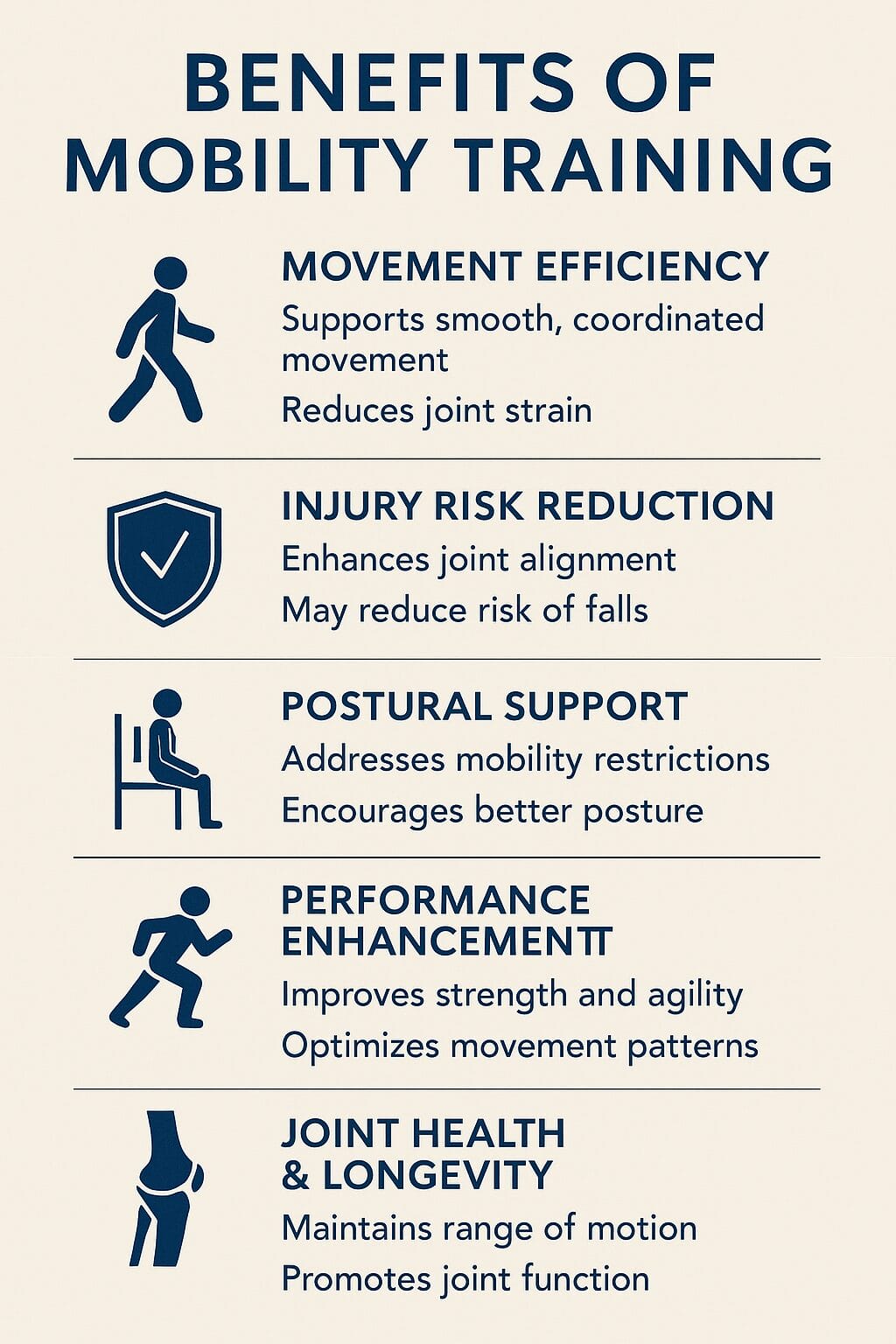
Mobility training offers a wide range of benefits across age groups and activity levels. It is often used in rehabilitation, performance enhancement, or preventative health programs. Mobility exercises can alleviate joint soreness by promoting better movement and reducing stiffness. Additionally, it helps prevent muscle injury by improving flexibility and reducing the risk of strains.
Movement Efficiency
- It supports smooth, coordinated movement during everyday tasks.
- Reduces compensatory movement patterns and muscle overuse by helping maintain proper form during exercises.
- Minimizes joint strain by promoting better mechanics and achieving optimal positions of muscles and joints.
Injury Risk Reduction
- Encourages better joint alignment and muscular balance.
- Helps protect connective tissues and muscles during load-bearing activities.
- May reduce fall risk and repetitive strain, particularly in older adults.
- Addresses stiff joint issues by increasing joint range of motion and reducing stiffness through mobility exercises.
- Prevents injuries by targeting areas that lack mobility, ensuring optimal movement patterns, and reducing compensatory muscle strain.
Postural Support
- Addresses mobility restrictions that may contribute to postural misalignment.
- Encourages spinal organization and better load distribution.
- Supports prolonged sitting or standing with less fatigue.
- Emphasizes maintaining hip width spacing between the knees during exercises like the cat-cow and downward-facing dog to ensure proper alignment and stability, which is crucial for targeting hip mobility and overall body balance.
- Suggests positioning the feet slightly wider than shoulder-width apart during deep squats to enhance stability and facilitate proper movement mechanics, which requires good ankle flexibility and core strength.
Performance Enhancement
- Provides a foundation for strength, speed, and agility.
- Optimizes load absorption and force transfer during complex movements.
- Enhances mind-body connection and motor control.
- Increasing movement depth with each repetition during dynamic stretches allows you to go deeper, enhancing effectiveness while preventing injury.
- Improving overall strength and mobility allows your body to move through a full range of motion, enhancing training quality and preventing injury.
Joint Health, Range of Motion, and Longevity
- Promotes synovial fluid distribution and joint nourishment.
- It may help manage osteoarthritis, impingement syndromes, or general stiffness.
- Builds capacity for a wide range of physical tasks, supporting independence with age.
- It helps prevent a stiff joint by increasing the joint range of motion and reducing tightness in surrounding soft tissues.
- Alleviates joint soreness by promoting better movement and reducing inflammation, which is crucial for athletes and active individuals.
Discover a practitioner near you.
Looking for a practitioner near you? Our extensive network of qualified professionals is here to help you.
Broad Principles of Effective Mobility Work
Effective mobility work isn’t about complexity or intensity but consistency, intention, and relevance. While the methods may vary, many practitioners build their approach around several foundational principles:
Consistency Over Intensity
- Regular, low-intensity mobility work often provides better long-term results than sporadic, intense sessions. Mobility training improves overall movement performance, enhancing physical capabilities and effectiveness in various activities.
- Small, frequent doses are often more effective than occasional deep stretching or advanced drills.
Intentional Movement
- Mobility work emphasizes slow, controlled motion rather than speed or range alone. Proper form during these exercises is crucial as it enhances training quality and prevents injuries.
- Precision and awareness are key to activating deeper support and motor control layers. Achieving better mobility allows for executing movements, like squats, with proper form, which in turn improves strength and reduces the risk of injury.
Addressing the Whole System
- The interplay between joints, fascia, muscles, and the nervous system influences proper mobility. Mobility refers to the motion of a joint, which is distinct from flexibility, which pertains to the length of muscles and connective tissues.
- Practitioners often evaluate patterns holistically, not just at the site of restriction.
Individual Relevance
- Not all bodies need the same type of mobility training.
- A person recovering from injury will require a different approach from someone training for high-performance sport.
- Consulting a physical therapist or other associated health professional can provide personalized recommendations for mobility exercises and joint health. Physical therapists can evaluate movements and suggest targeted routines to alleviate discomfort and enhance overall mobility, especially for individuals experiencing chronic pain or those seeking to improve their range of motion.
Integration with Other Modalities
- Mobility is most effective when paired with strength work, breath control, load tolerance, and functional training. Mobility training improves overall movement performance, enhancing physical capabilities and effectiveness in various activities when combined with these modalities.
- Practitioners may also use it alongside manual therapy, rehabilitation, or movement coaching.
Types of Mobility Exercises and Approaches You May Encounter
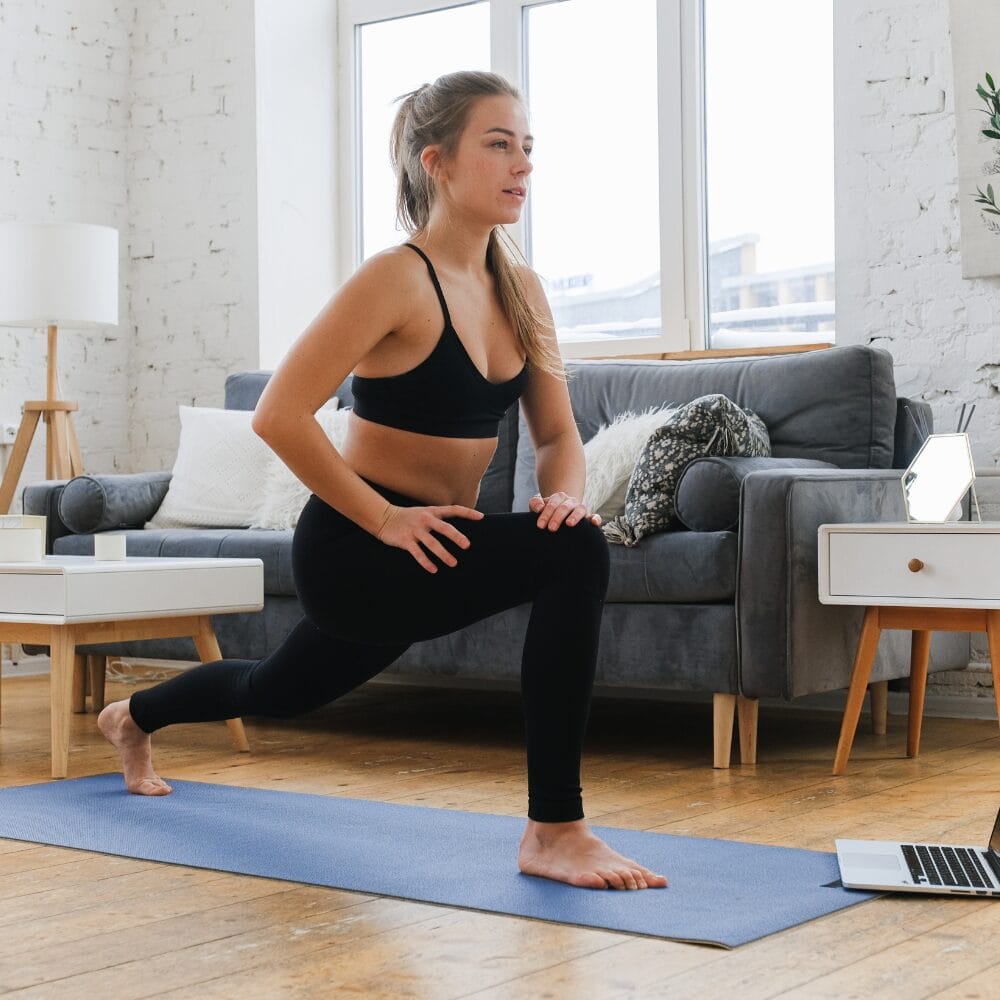
Practitioners often integrate mobility techniques into a broader care or training plan. Some of the methods you might come across include:
Dynamic movement-based warm-ups: Low-intensity, rhythmical movements (e.g., arm circles, leg swings) that prepare joints for use.
Joint-focused techniques: Intentional joint articulations, often done slowly and with active control, to explore range and coordination.
Soft tissue preparation: Tools like foam rollers or massage balls stimulate blood flow and reduce tension in surrounding tissues.
Resistance or banded mobility drills: Exercises using bands to create feedback and encourage control in new ranges of motion.
Postural retraining and breathwork: Subtle movement practices that help recalibrate alignment and nervous system tone.
Strength-based mobility work: Functional, loaded movements (e.g., deep squats, Cossack squats, Jefferson curls) that build usable range and stability.
While many of these tools are widely demonstrated online, their value comes from context. A practitioner tailors them to your needs, assesses their effect over time, and integrates them into a wider strategy.
'Best' Mobility Exercises to Explore with Guidance
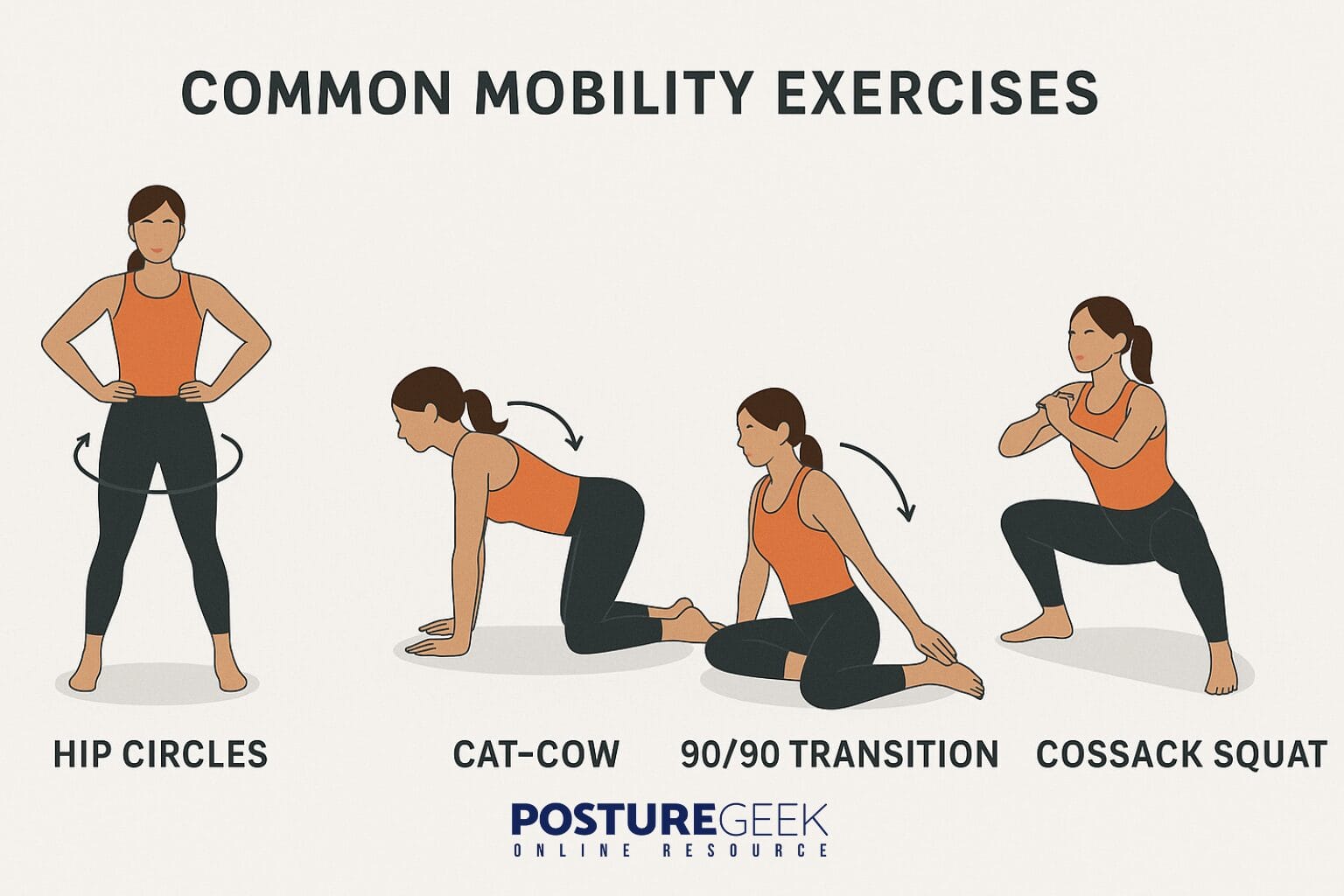
Mobility work takes many forms, from gentle daily movement to advanced functional exercises in clinical or athletic settings. Below is a broader sample of movements and techniques practitioners often use to support joint health, movement freedom, and postural control. These examples are illustrative rather than prescriptive and should be approached with professional guidance.
Foundational and Everyday Explorations
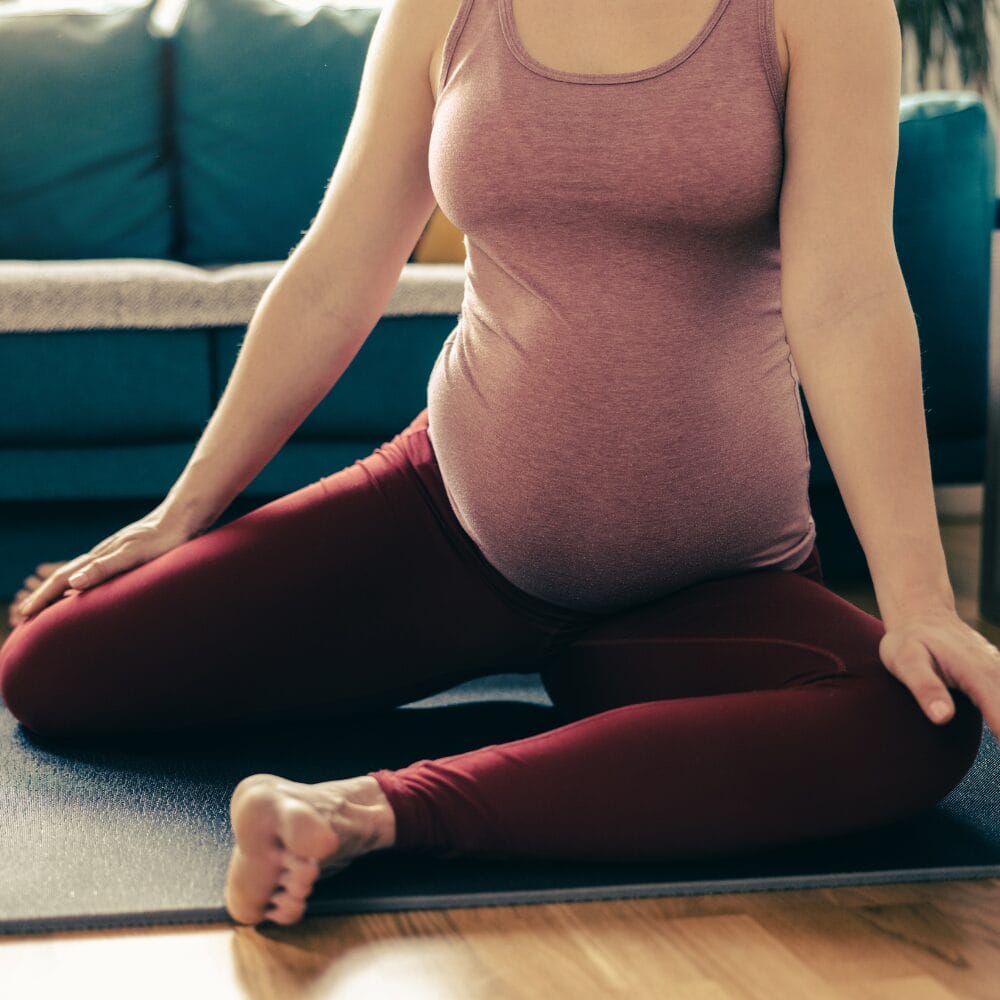
Hip Circles (Standing or Quadruped): With feet hip-width apart or on all fours, slowly articulate the hip joint in large, deliberate circles. Helps wake up the hip capsule motion and test the available range.
90/90 Transitions: Seated with both knees bent at 90 degrees, rotate the legs side to side to explore internal and external rotation. Often used as both an assessment (to track mobility progress) and training for hip joint independence.
Cat-Cow Spinal Waves: Performed from a hands-and-knees position, this movement alternates between spinal flexion and extension. A basic yet powerful tool to improve segmental awareness and spinal mobility.
Mobility-Strength Hybrids
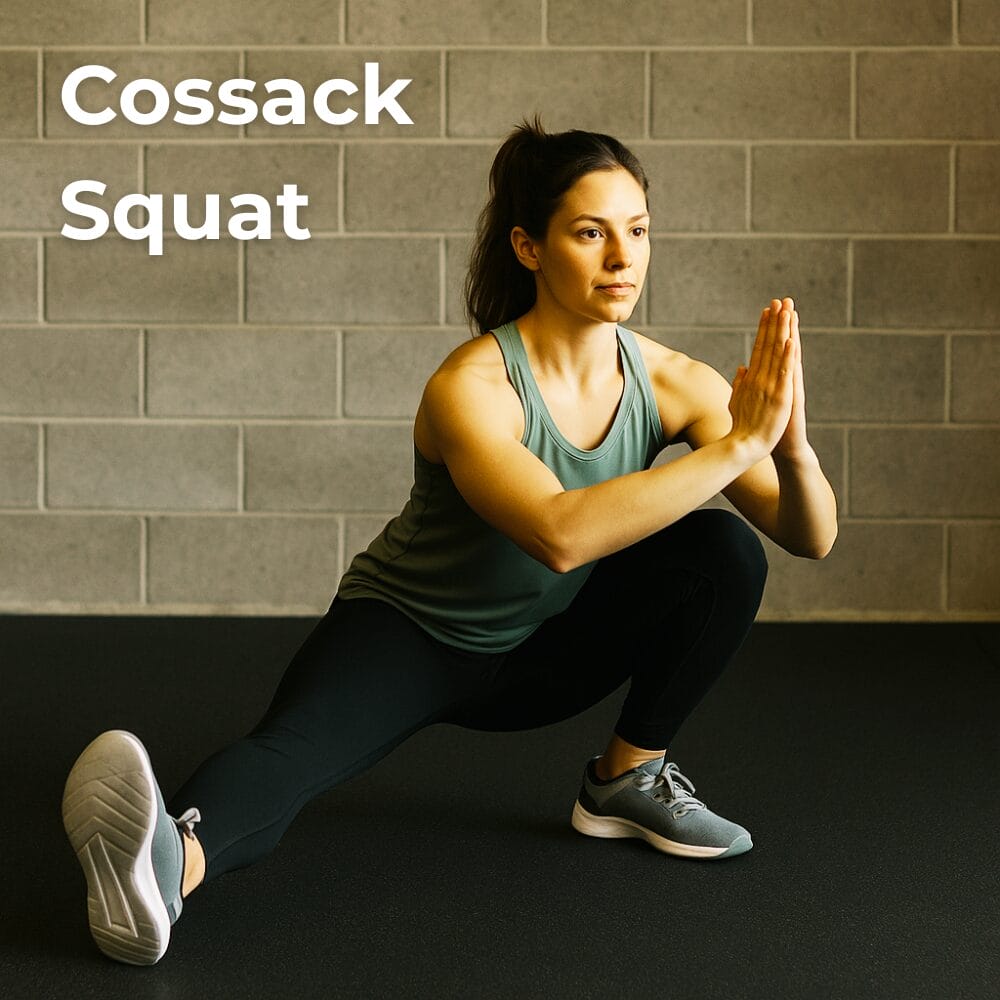
Cossack Squats: A deep lateral squat performed by shifting weight from side to side with one leg straight and the other bent. Improves hip adduction and ankle dorsiflexion while strengthening the legs.
Jefferson Curls: A loaded spinal articulation movement is performed slowly from a starting position, standing, and moving to a forward fold. Used under supervision to build resilience and control through spinal flexion.
Active Hip Flexor Work: Instead of static hip flexor stretches, this involves controlled end-range leg lifting into hip flexion while maintaining trunk and pelvic stability. Can be done supine, seated, or in a supported lunge position. Trains strength and control where hip flexors tend to be short or inhibited.
Wall- and Floor-Based Techniques
Wall Shoulder Slides: Standing with your back against a wall, slide your arms upward while keeping contact. This supports scapular control and thoracic extension, crucial for maintaining good posture.
Dead Bug Variations: A core activation series that challenges spinal stability and coordination between limbs, often integrated into mobility warm-ups.
Supine Windshield Wipers: Lying on your back with knees bent and feet hip width apart, rotate knees side to side. Useful for hip and lower back mobility, especially in early phases of movement recovery.
Integrative Practices
Controlled Articular Rotations (CARs): Joint-specific circular movements performed actively with maximum control and core engagement. Used widely in systems like Functional Range Conditioning (FRC) to assess and maintain joint health.
Functional range holds: A method of holding end-range positions under tension. It helps expand the usable range of motion by strengthening it at its limits.
Band-Assisted Joint Mobilizations: Using resistance bands to provide traction or feedback during movement (e.g., hip band distractions). Often taught by therapists or strength coaches.
These tools span a spectrum from rehabilitation to performance enhancement. Importantly, their value lies not just in the movement but in how they are selected, sequenced, and coached. A trained practitioner can help determine which methods are appropriate, modify them based on your structure and history, and ensure progress is guided and safe.
Whether your focus is releasing stiffness, improving posture, or preparing for physical goals, these exercises demonstrate the diversity and depth of modern mobility practice.
Understanding Controlled Articular Rotations (CARs)
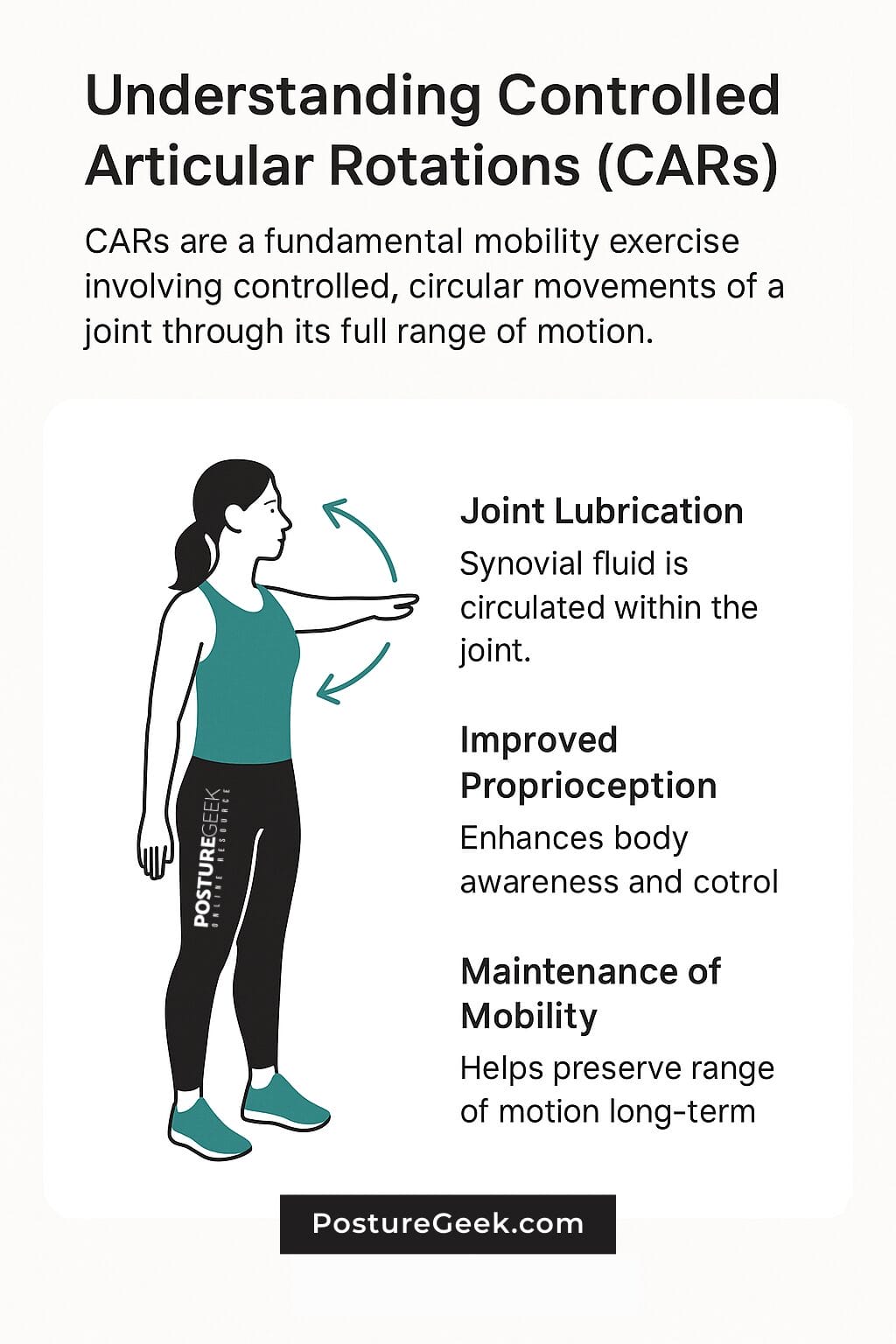
One example of a technique some movement professionals use is Controlled Articular Rotations (CARs). This method involves a joint’s slow, deliberate circular movements to explore and reinforce usable range. Each rotation is performed with active tension, core engagement, and attention to joint control. It is important to note that mobility refers to the motion of a joint, which is distinct from flexibility, which pertains to the length of muscles and connective tissues.
CARs may support:
- Joint lubrication and nutrient distribution
- Improved proprioception and neuromuscular awareness
- Maintenance of mobility in areas not frequently used through daily movement
CARs are not intended for self-diagnosis or treatment. They are typically integrated into a broader movement or therapeutic framework under supervision.
Importance of Hip Mobility
Hip mobility is a cornerstone of overall physical health, enabling individuals to perform daily activities easily and efficiently. Limited hip range can lead to poor posture, back pain, and decreased athletic performance. Incorporating hip mobility exercises into your daily routine can significantly improve your range of motion, reduce muscle soreness, and potentially prevent muscle strains. Practitioners often recommend targeting the hip flexors, glutes, and lower back to maintain optimal hip mobility. Practicing exercises such as lunges, leg swings, and hip circles can enhance your hip mobility and reduce the risk of injury. These targeted exercises improve your movement patterns and support better posture and overall musculoskeletal health.
Proprioception and Balance
Proprioception, the body’s ability to sense its position and movement in space, is crucial for balance, coordination, and overall mobility. Poor proprioception can lead to balance problems, increased risk of injury, and decreased athletic performance. Mobility exercises that challenge balance and proprioception, such as single-leg squats and balance boards, can significantly improve overall mobility and reduce the risk of injury. Many modalities recommend incorporating proprioception exercises into daily routines to enhance balance, coordination, and overall mobility. Focusing on these exercises can improve your body’s awareness and control, leading to more efficient and safer movement patterns.
Aging and Mobility
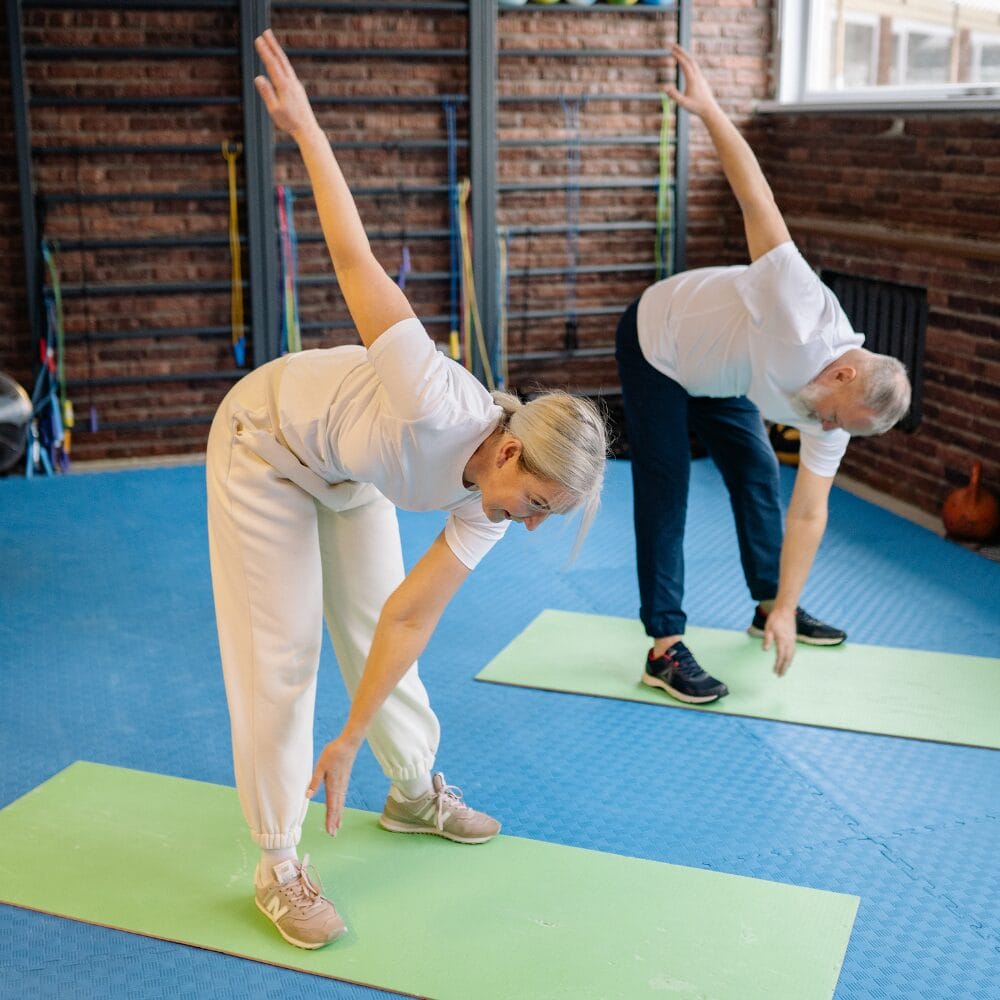
As we age, maintaining mobility becomes increasingly important. Aging often leads to a decline in joint lubrication and muscle flexibility, resulting in decreased mobility. Regular mobility training can help mitigate these age-related changes, improve joint health, and reduce the risk of chronic health conditions. Therapists often recommend incorporating mobility exercises that target the hips, knees, and lower back to improve mobility and reduce the risk of injury. By practicing mobility exercises and maintaining a regular physical activity routine, individuals can enhance their mobility and reduce the risk of age-related health problems. This proactive approach to mobility can support a more active and independent lifestyle as you age.
The Role of Practitioners in Mobility Work
Mobility is rarely just about stiff joints or tight muscles. It often reflects deeper patterns—compensation, adaptation, inactivity, or overload. That’s why working with a trained professional can offer deeper insights and more sustainable results.
Practitioners may help with:
- Evaluating mobility in the context of functional tasks and postural tendencies
- Identifying contributing factors to movement restrictions (e.g., fascial tension, muscle inhibition)
- Selecting mobility techniques that are safe, relevant, and progressive
- Monitoring the impact of mobility work and adjusting as needed over time
Examples of how practitioners integrate mobility:
- A physiotherapist may design a rehab plan that gradually reintroduces joint movement post-injury.
- A personal trainer might add targeted mobility sequences to a strength program.
- A structural integration therapist could combine hands-on fascia work with movement retraining for lasting change.
What to Look For in a Mobility-Focused Practitioner
If you’re looking to explore mobility work as part of your health journey, consider finding a practitioner who:
- Takes a whole-body, system-based view of movement
- Conducts assessments and adapts their approach to your needs
- Has experience working with diverse populations and physical conditions
- Communicates clearly, educates you along the way, and fosters collaboration
Practitioners listed in the PostureGeek Directory reflect diverse disciplines, but all share a commitment to mobility-informed, client-centered care.
A Note of Caution
Mobility training is best approached as a long-term investment, not a quick fix. While online routines and trending exercises can be helpful for inspiration, they often lack nuance and personalization. In some cases, they can even aggravate existing conditions.
When mobility limitations affect your posture, comfort, or performance, a qualified practitioner can help clarify what’s happening and guide you toward sustainable improvement.
Final Thoughts
Mobility training is not just for athletes or fitness enthusiasts. It’s for anyone who wants to move more freely, age more gracefully, or feel more connected to their body. Mobility exercises improve overall movement performance, highlighting their benefits in enhancing physical capabilities and effectiveness in various activities. From easing everyday tension to enhancing how you perform, mobility is foundational.
However, how that training looks and where it fits into your health journey depends on your unique goals, limitations, and background. It’s not about doing more, it’s about doing what matters.
If you’re curious about where to begin, start with support. With the right practitioner, mobility work becomes less about drills and more about discovering how your body is meant to move. That’s when transformation begins.
Resources
Articles:
The Effects of Eccentric Strength Training on Flexibility and Strength
- Authors: Vogt S., et al.
- Summary: This systematic review analyzed 18 studies and found that eccentric strength training significantly improves both flexibility and strength, particularly in the lower limbs. These findings support the integration of strength-based mobility exercises, such as Jefferson curls and Cossack squats, to enhance joint control and range of motion.
- Read More
The Influence of Mobility Training on the Myofascial Structures of the Lower Back
- Authors: Schleip R., et al.
- Summary: This study examined the effects of a multicomponent mobility routine on muscular and fascial stiffness, flexibility, and subjective well-being. The results indicated that targeted mobility exercises can reduce myofascial stiffness and improve flexibility, underscoring the importance of mobility training in maintaining musculoskeletal health.
- Read More
Musculoskeletal Exercise: Its Role in Promoting Health and Longevity
- Authors: Fragala M.S., et al.
- Summary: This narrative review discusses how musculoskeletal exercises, including mobility training, contribute to health and longevity. It emphasizes the importance of maintaining joint flexibility and muscle strength to prevent age-related declines in mobility and function.
- Read More
PLEASE NOTE
PostureGeek.com does not provide medical advice. This information is for educational purposes only and is not intended to be a substitute for professional medical attention. The information provided should not replace the advice and expertise of an accredited health care provider. Any inquiry into your care and any potential impact on your health and wellbeing should be directed to your health care provider. All information is for educational purposes only and is not intended to be a substitute for professional medical care or treatment.
About the author
Join our conversation online and stay updated with our latest articles.
Find Expert Posture Practitioner Near You
Discover our Posture Focused Practitioner Directory, tailored to connect you with local experts committed to Improving Balance, Reducing Pain, and Enhancing Mobility.
